Time-lapse zirconography: Imaging punctuated continental evolution
Affiliations | Corresponding Author | Cite asKeywords: continental growth, zircon, isotope geochemistry
- Share this article





-
Article views:9,754Cumulative count of HTML views and PDF downloads.
- Download Citation
- Rights & Permissions
Abstract

Armstrong, R.L. (1991) The persistent myth of crustal growth. Australian Journal of Earth Sciences 38, 613-630.
; Bowring and Housh, 1995Bowring, S.A., Housh, T. (1995) The Earth early evolution. Science 269, 1535-1540.
; Wilde et al., 2001Wilde, S.A., Valley, J.W., Peck, W.H., Graham, C.M. (2001) Evidence from detrital zircons for the existence of continental crust and oceans on the Earth 4.4 Gyr ago. Nature 409, 175-178.
; Harrison et al., 2005Harrison, T.M., Blichert-Toft, J., Muller, W., Albarède, F., Holden, P. Mojzsis, S.J. (2005) Heterogeneous Hadean hafnium: Evidence of continental crust at 4.4 to 4.5 Ga. Science 310, 1947-1950.
; Hawkesworth et al., 2010Hawkesworth, C.J., Dhuime, B., Pietranik, A.B., Cawood, P.A., Kemp, A.I.S., Storey, C.D. (2010) The generation and evolution of the continental crust. Journal of the Geological Society 167, 229-248.
; Condie and Kroener, 2013Condie, K.C., Kroener, A. (2013) The building blocks of continental crust: Evidence for a major change in the tectonic setting of continental growth at the end of the Archean. Gondwana Research 23, 394-402.
). Understanding its growth is central to a broad range of research, including the geodynamics of the planet's interior (O'Neill et al., 2007O'Neill, C., Lenardic, A., Moresi, L., Torsvik, T.H., Lee, C.T.A. (2007) Episodic Precambrian subduction. Earth and Planetary Science Letters 262, 552-562.
; Korenaga, 2013Korenaga, J. (2013) Initiation and evolution of plate tectonics on Earth: Theories and observations. Annual Review of Earth and Planetary Sciences 41, 117-151.
), the evolution of the atmosphere (Barley et al., 2005Barley, M.E., Bekker, A., Krapez, B. (2005) Late Archean to Early Paleoproterozoic global tectonics, environmental change and the rise of atmospheric oxygen. Earth and Planetary Science Letters 238, 156-171.
) and even the evolution of life itself (Lowe and Tice, 2007Lowe, D.R., Tice, M.M. (2007) Tectonic controls on atmospheric, climatic, and biological evolution 3.5-2.4 Ga. Precambrian Research 158, 177-197.
). The growth of the continents is a competition between rates of crustal production and destruction (Armstrong, 1991Armstrong, R.L. (1991) The persistent myth of crustal growth. Australian Journal of Earth Sciences 38, 613-630.
; Hawkesworth et al., 2010Hawkesworth, C.J., Dhuime, B., Pietranik, A.B., Cawood, P.A., Kemp, A.I.S., Storey, C.D. (2010) The generation and evolution of the continental crust. Journal of the Geological Society 167, 229-248.
), but which of these dominates the CC record is debated. Here I examine a large database of detrital zircon U-Pb ages (n > 200,000; Voice et al., 2011Voice, P.J., Kowalewski, M., Eriksson, K.A. (2011) Quantifying the timing and rate of crustal evolution: Global compilation of radiometrically dated detrital zircon grains. Journal of Geology 119, 109-126.
) as a function of the age of the sedimentary rock in which they are found. This provides snapshots of the Earth's CC age distribution through time; in essence, producing a time-lapse movie of CC evolution. The analysis strongly indicates that the growth of the CC was episodic.Figures and Tables
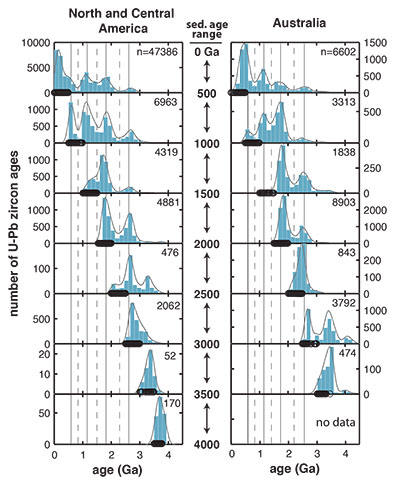 Figure 1 Frequency of U-Pb crystallisation ages in detrital zircons from North + Central America and Australia as a function of the age of the sediment in which they were found (different panels). Data from Voice et al., 2011. Each panel shows a histogram of zircon ages from sediments deposited during a 500 Myr interval, starting from 4000 Ma at the bottom and becoming younger upwards in the figure. Moving from bottom to top, each panel can be viewed as a snapshot in a time-lapse movie of crustal age distribution. For each sediment age interval, both a histogram of the U-Pb ages (blue, scale on y-axis) and a kernel density function (grey curves, kernel width = 100 Myr) are shown. Sediment ages are the reported minimum ages and are shown by black open circles along x-axis. The total number of zircon analyses for each bin is shown in upper right hand corner of each panel. The sediment age range is also shown between the two panels. Reference lines are shown for peaks (solid lines) and troughs (dashed). These peaks and troughs persist in sediments of all ages and on all continents (see Figs. S-1 and S-2) indicating that destruction of pre-existing crust did not produce the age peaks or troughs. | 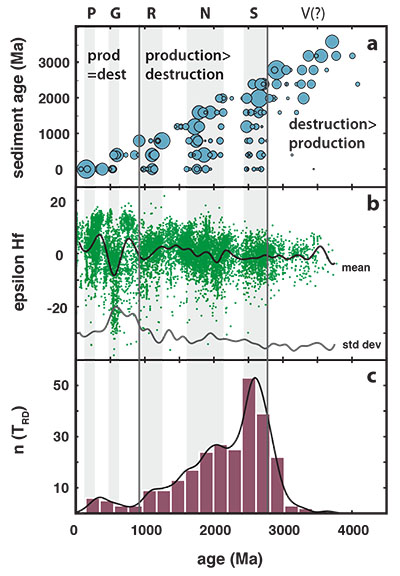 Figure 2 Comparison of zircon U-Pb ages and Hf isotopic compositions with Re depletion ages of mantle xenoliths. (a) Positions of U-Pb zircon age peaks (blue circles) as a function of the age of the sediment in which they were found (sediment age interval = 400 Myr). The size of the circle is scaled to the height of the peak, times the number of zircons in each sediment interval, to give an indication of the robustness of the peak (see Fig. S-4 for an unscaled version). The vertical bands of dots (highlighted by grey bands) correspond to times of super continent formation: Pangea (P), Gondwana (G), Rodinia (R), Nuna (N), Superia (S) and Vaalbara (V). Only a few small age peaks are found around 1.5 and 2.3 Ga, indicating that little continental crust of this age ever existed. See Methods in Supplementary Information for discussion. (b) Epsilon Hf of zircons versus zircon crystallisation age (data from Belousova et al., 2010). Running mean (black line) and standard deviation (grey line) are also shown (window for averaging = 100 Myr). Note the lack of large variations in either the mean or standard deviations until after 1 Ga. (c) Histogram (red bars) of Re depletion age of mantle xenoliths showing that highly depleted lithosphere formation rates were highest around 2.7 Ga and decreased to near zero by ~1 Ga (data from Pearson et al., 2007). The evolution of the continents is divided into three time periods: destruction rates > growth rates (4.5-3 Ga), growth rates > destruction rates (3-1 Ga) and growth rates = destruction rates (1 Ga - present), see text and Figure 3 for discussion. The boundaries at 1 and 3 Ga correspond to the major changes in rates of depleted mantle lithosphere formation. | 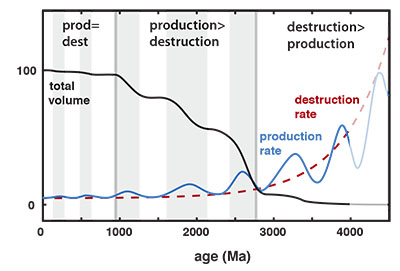 Figure 3 Schematic model of continental growth consistent with the zircon U-Pb and Hf data. The lack of a scale bar on the y-axis indicates that the model shown here is speculative and should not be taken as quantitative. Hypothetical rates of continent growth (blue solid line) and destruction (red dashed line) are shown as exponentially decreasing (assuming the early Earth was hotter and mantle convection/melting was more vigorous), with the growth rate oscillating. Destruction (preservation) rates probably also varied, but are not shown for clarity. The black line indicates cumulative crustal volume starting at 0 and ending at the present day volume. Prior to ~3 Ga, destruction outpaces growth and little continental volume is preserved. Prior to 4 Ga (faded lines), no crust is preserved, other than as detrital zircons. The hypothesis suggested here is that the decrease in destruction rates was faster than crustal growth rates, such that at ~3 Ga, growth outpaces destruction and significant volumes of continental crust can be preserved. This corresponds to the formation of highly depleted mantle (Fig. 2c) and possibly to the onset of plate tectonics. By ~1 Ga, both growth and destruction rates may have fallen to minimal values, producing little net crustal growth. Reworking of existing crust becomes the dominant zircon-producing process, as suggested by the large variations in zircon Hf isotopic composition after 1 Ga. Grey bands are taken from Figure 2. |
| Figure 1 | Figure 2 | Figure 3 |
Supplementary Figures and Tables
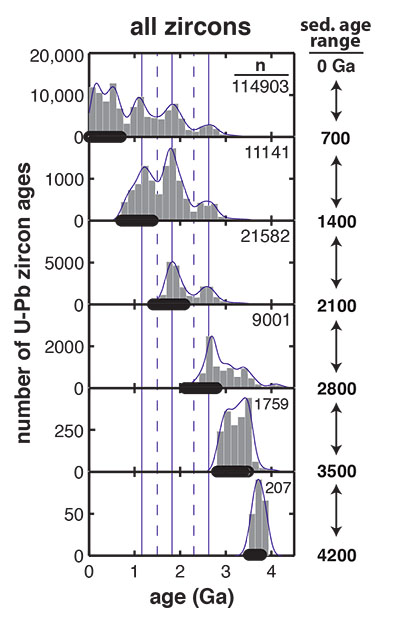 Figure S-1 Distribution of U-Pb ages in detrital zircons (histograms and overlain kernel density functions) in sediments of different ages. Data from Voice et al., 2011. Sediment ages are the reported minimum ages and are shown by black circles along x-axis. Sediments were binned in 700 Myr increments. Total number of zircon analyses for each bin is shown in upper right hand corner of each panel. Sediment age range shown along right side of figure. Grey vertical bands show three main peaks in peaks in zircon age distribution. Dashed lines show two main minima in age spectrum. These peaks and minima persist in sediments of all ages and on all continents (see online figures for plots for all continents and a range of sediment age bins). The invariance of these peaks through time suggests that they are pulses of crustal growth. | 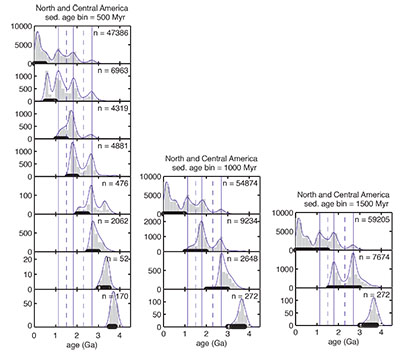 Figure S-2 Zircon U-Pb age distribution for detrital zircons from North & Central America, Australia, Europe, South America, Africa, Asia and India using sediment age intervals of 500, 1000 and 1500 Myr (indicated at the top of each panel). Same symbols and labelling as in Figure S-1. | 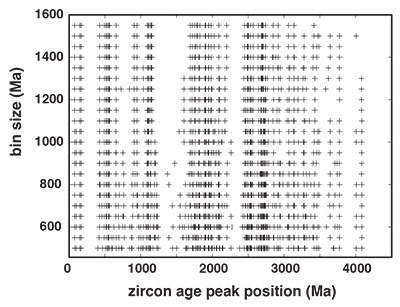 Figure S-3 Position of zircon age peaks (crosses) as a function of the bin size for the sediments. See Methods for peak finding algorithm. The position of the age peaks at 2.7, 1.8 and 1.2 Ga (vertical bands of data) and troughs at 2.4 and 1.4 Ga (vertical gaps in data) are robust and do not vary with the size of the bin size. | 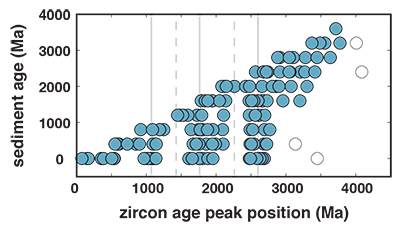 Figure S-4 Position of zircon age peaks (blue circles) as a function of the age of the sediment they are found within. Same as Figure 2a, but with peak positions (blue circles) not scaled to the number of zircon and peak height. Vertical bands of data show the age peaks at 2.7, 1.8 and 1.2 Ga, that do not vary with sediment age. Vertical bands with no data show troughs in zircon age distributions that appear on all continents in sediments of all ages. Open circles are for Australia and are likely due to the high sampling density there (see text). | 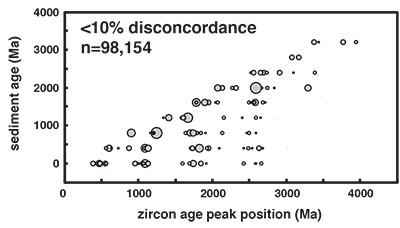 Figure S-5 Position of zircon age peaks (circles) as a function of the age of the sediment they are found within. Same as Figure 2a, but only using zircons with U-Pb ages with <10 % discordance (Voice et al., 2011). The number of data are reduced to 98,154. The same pattern is seen in the filtered and unfiltered data, indicating that discordance is not biasing the data. |
| Figure S-1 | Figure S-2 | Figure S-3 | Figure S-4 | Figure S-5 |
top
Introduction
Zircons found in sediments and sedimentary rocks (detrital zircons) are primary records of CC age distribution (Rino et al., 2004
Rino, S., Komiya, T., Windley, B.F., Katayama, I., Motoki, A., Hirata, T. (2004) Major episodic increases of continental crustal growth determined from zircon ages of river sands; implications for mantle overturns in the Early Precambrian. Physics of the Earth and Planetary Interiors 146, 369-394.
; Belousova et al., 2010Belousova, E.A., Kostitsyn, Y.A., Griffin, W.L., Begg, G.C., O'Reilly, S.Y., Pearson, N.J. (2010) The growth of the continental crust: Constraints from zircon Hf-isotope data. Lithos 119, 457-466.
; Hawkesworth et al., 2010Hawkesworth, C.J., Dhuime, B., Pietranik, A.B., Cawood, P.A., Kemp, A.I.S., Storey, C.D. (2010) The generation and evolution of the continental crust. Journal of the Geological Society 167, 229-248.
; Condie et al., 2011Condie, K.C., Bickford, M.E., Aster, R.C., Belousova, E., Scholl, D.W. (2011) Episodic zircon ages, Hf isotopic composition, and the preservation rate of continental crust. Geological Society of America Bulletin 123, 951-957.
; Voice et al., 2011Voice, P.J., Kowalewski, M., Eriksson, K.A. (2011) Quantifying the timing and rate of crustal evolution: Global compilation of radiometrically dated detrital zircon grains. Journal of Geology 119, 109-126.
). All global compilations of detrital zircon U-Pb ages display peaks at 2.7, 1.9 and 1.2 Ga (Fig. 1; Rino et al., 2004Rino, S., Komiya, T., Windley, B.F., Katayama, I., Motoki, A., Hirata, T. (2004) Major episodic increases of continental crustal growth determined from zircon ages of river sands; implications for mantle overturns in the Early Precambrian. Physics of the Earth and Planetary Interiors 146, 369-394.
; Belousova et al., 2010Belousova, E.A., Kostitsyn, Y.A., Griffin, W.L., Begg, G.C., O'Reilly, S.Y., Pearson, N.J. (2010) The growth of the continental crust: Constraints from zircon Hf-isotope data. Lithos 119, 457-466.
; Hawkesworth et al., 2010Hawkesworth, C.J., Dhuime, B., Pietranik, A.B., Cawood, P.A., Kemp, A.I.S., Storey, C.D. (2010) The generation and evolution of the continental crust. Journal of the Geological Society 167, 229-248.
; Voice et al., 2011Voice, P.J., Kowalewski, M., Eriksson, K.A. (2011) Quantifying the timing and rate of crustal evolution: Global compilation of radiometrically dated detrital zircon grains. Journal of Geology 119, 109-126.
; Dhuime et al., 2012Dhuime, B., Hawkesworth, C.J., Cawood, P.A., Storey, C.D. (2012) A change in the geodynamics of continental growth 3 billion years ago. Science 335, 1334-1336.
; Condie and Kroener, 2013Condie, K.C., Kroener, A. (2013) The building blocks of continental crust: Evidence for a major change in the tectonic setting of continental growth at the end of the Archean. Gondwana Research 23, 394-402.
). Smaller, less consistently observed peaks are observed around 3.3, 0.6 and 0.2 Ga. These peaks match peaks in other estimates of CC age distributions (Condie, 1998Condie, K.C. (1998) Episodic continental growth and supercontinents: a mantle avalanche connection? Earth and Planetary Science Letters 163, 97-108.
) and correspond to the formation of the most recent supercontinents (Pangea 0.2, Gondwana 0.6, Rhodinia 1.2 Ga). Based upon this, the peaks at 1.9 (Nuna), 2.7 (Superia) and 3.3 (Vaalbara) have also been proposed to be associated with supercontinents (Evans, 2013Evans, D.A.D. (2013) Reconstructing pre-Pangean supercontinents. Geological Society of America Bulletin 125, 1735-1751.
).The fundamental question is whether the age peaks mostly reflect variations in CC production rates or are mainly the result of varying destruction rates. The U-Pb ages record the time of crystallisation of the zircon, but not whether it was formed by new volumes of crust or by reworking of existing crust. If the number of zircons within a given age range are proportional to the amount of new (juvenile) crust being added at that time, then the peaks and troughs suggest major variations in crustal formation rates. This line of reasoning has led to fundamentally punctuated models of Earth evolution, involving large mantle overturn events and even cessation of plate tectonics (Condie, 1998
Condie, K.C. (1998) Episodic continental growth and supercontinents: a mantle avalanche connection? Earth and Planetary Science Letters 163, 97-108.
; Rino et al., 2004Rino, S., Komiya, T., Windley, B.F., Katayama, I., Motoki, A., Hirata, T. (2004) Major episodic increases of continental crustal growth determined from zircon ages of river sands; implications for mantle overturns in the Early Precambrian. Physics of the Earth and Planetary Interiors 146, 369-394.
; Lowe and Tice, 2007Lowe, D.R., Tice, M.M. (2007) Tectonic controls on atmospheric, climatic, and biological evolution 3.5-2.4 Ga. Precambrian Research 158, 177-197.
; O'Neill et al., 2007O'Neill, C., Lenardic, A., Moresi, L., Torsvik, T.H., Lee, C.T.A. (2007) Episodic Precambrian subduction. Earth and Planetary Science Letters 262, 552-562.
; Pearson et al., 2007Pearson, D.G., Parman, S.W., Nowell, G.M. (2007) A link between large mantle melting events and continent growth seen in osmium isotopes. Nature 449, 202-205.
; Arndt and Davaille, 2013Arndt, N., Davaille, A. (2013) Episodic Earth evolution. Tectonophysics 609, 661-674.
).However, connecting the number of zircons to crustal production rates is not straightforward. Decreased numbers of zircons at a given age (troughs in histograms) could be the results of erosion and/or metamorphic processes, or simply due to incomplete sampling (Armstrong, 1991
Armstrong, R.L. (1991) The persistent myth of crustal growth. Australian Journal of Earth Sciences 38, 613-630.
). The age peaks could also reflect times of reduced destruction (greater preservation), rather than variations in additions of new volume to the CC (Belousova et al., 2010Belousova, E.A., Kostitsyn, Y.A., Griffin, W.L., Begg, G.C., O'Reilly, S.Y., Pearson, N.J. (2010) The growth of the continental crust: Constraints from zircon Hf-isotope data. Lithos 119, 457-466.
; Hawkesworth et al., 2010Hawkesworth, C.J., Dhuime, B., Pietranik, A.B., Cawood, P.A., Kemp, A.I.S., Storey, C.D. (2010) The generation and evolution of the continental crust. Journal of the Geological Society 167, 229-248.
; Cawood et al., 2012Cawood, P.A., Hawkesworth, C.J., Dhuime, B. (2012) Detrital zircon record and tectonic setting. Geology 40, 875-878.
). Also, because metamorphism can produce new zircons (reworking), increases in orogenic continental collisions could produce a spike in zircon formation without adding new CC volume (Hawkesworth et al., 2010Hawkesworth, C.J., Dhuime, B., Pietranik, A.B., Cawood, P.A., Kemp, A.I.S., Storey, C.D. (2010) The generation and evolution of the continental crust. Journal of the Geological Society 167, 229-248.
; Cawood et al., 2012Cawood, P.A., Hawkesworth, C.J., Dhuime, B. (2012) Detrital zircon record and tectonic setting. Geology 40, 875-878.
). This would also produce the observed correlations with tectonic cycles. Studies of Hf isotopes in zircons have generally suggested such processes are the dominant control on the U-Pb age spectrum (Belousova et al., 2010Belousova, E.A., Kostitsyn, Y.A., Griffin, W.L., Begg, G.C., O'Reilly, S.Y., Pearson, N.J. (2010) The growth of the continental crust: Constraints from zircon Hf-isotope data. Lithos 119, 457-466.
; Hawkesworth et al., 2010Hawkesworth, C.J., Dhuime, B., Pietranik, A.B., Cawood, P.A., Kemp, A.I.S., Storey, C.D. (2010) The generation and evolution of the continental crust. Journal of the Geological Society 167, 229-248.
; Dhuime et al., 2012Dhuime, B., Hawkesworth, C.J., Cawood, P.A., Storey, C.D. (2012) A change in the geodynamics of continental growth 3 billion years ago. Science 335, 1334-1336.
).Here I examine the U-Pb age spectra of detrital zircons as a function of the time at which the zircons were incorporated into sediments (time-lapse analysis; see Methods section in Supplementary Information for details). In essence, this provides a time-lapse movie of CC evolution and the age-old contest between growth and destruction. This requires a large number of analyses, and to my knowledge has only been performed on a database of Australian zircons (Hawkesworth et al., 2010
Hawkesworth, C.J., Dhuime, B., Pietranik, A.B., Cawood, P.A., Kemp, A.I.S., Storey, C.D. (2010) The generation and evolution of the continental crust. Journal of the Geological Society 167, 229-248.
). A recent compilation contains over 200,000 detrital zircon U-Pb ages (Voice et al., 2011Voice, P.J., Kowalewski, M., Eriksson, K.A. (2011) Quantifying the timing and rate of crustal evolution: Global compilation of radiometrically dated detrital zircon grains. Journal of Geology 119, 109-126.
), providing the opportunity to do the time-lapse analyses on a global scale. A key point about the time-lapse analysis is that it minimises many biases that may exist in the zircon record. Each new rearrangement of continental blocks formed during the supercontinent cycle produces a different spatial distribution of crustal blocks. So rivers sampling older supercontinents should not be subject to the same sampling bias as today's river basins. If they yield the same zircon age spectrum (which they do), then this is quite strong evidence that sampling bias (or incomplete sampling) is not dominating the record.top
Results
The main result of the time-lapse analysis is that the major U-Pb age peaks around 1.2, 1.9 and 2.7 Ga, are persistent through time (Figs. 1, 2, online supplementary figures). These age peaks appear prominently in sediments laid down immediately after the age of the peak, and persist in all younger sediments (vertical bands of data in Fig. 2a). Troughs in the data around 2.3 and 1.5 Ga are also persistent (vertical bands with no data in Fig. 2a). Even in sediments formed just after the troughs, no peaks are seen on any continent. The minor peaks at 0.2 and 0.6 also persist in time, but because they are relatively recent, it is difficult to evaluate their long-term evolution. In detail, there is some variation in the age of the U-Pb peaks between continents. The peak positions vary on the order of 100-200 Myr (Fig. 2a). For example, the '2.7' Ga peak in Australia actually occurs around 2.5 Ga, while in North and Central America it occurs closer to 2.7 Ga (Fig. 1). One can think of it as the Superia age peak band.
Though the peak positions are relatively constant through time, the relative height of the age peaks are not. For the best sampled continents (North America and Australia; Fig. 1), the height of each age peak decreases fairly regularly with sediment age. The result is that in the most recent sediments, there is a general descending pattern in peak heights towards older ages. This is also seen on the other continents. The height of the age peaks should be quite sensitive to sample biasing. Thus in this study, it is peak positions that are primarily interpreted. However, the regularity of the decrease in the age peaks through time is remarkable.
Prior to 3 Ga, the U-Pb age peaks are not persistent. In general there is only one age peak, which is the same as the age of sediments and evolves through time. The main exception to this is Australia, which has been the subject of intense scrutiny due to the discovery of Hadean zircons in the Jack Hills (Mojzsis et al., 2001
Mojzsis, S.J., Harrison, T.M., Pidgeon, R.T. (2001) Oxygen-isotope evidence from ancient zircons for liquid water at the Earth's surface 4,300 Myr ago. Nature 409, 178-181.
; Wilde et al., 2001Wilde, S.A., Valley, J.W., Peck, W.H., Graham, C.M. (2001) Evidence from detrital zircons for the existence of continental crust and oceans on the Earth 4.4 Gyr ago. Nature 409, 175-178.
; Crowley et al., 2005Crowley, J.L., Myers, J.S., Sylvester, P.J., Cox, R.A. (2005) Detrital zircon from the Jack Hills and Mount Narryer, Western Australia: Evidence for diverse > 4.0 Ga source rocks. Journal of Geology 113, 239-263.
; Harrison et al., 2005Harrison, T.M., Blichert-Toft, J., Muller, W., Albarède, F., Holden, P. Mojzsis, S.J. (2005) Heterogeneous Hadean hafnium: Evidence of continental crust at 4.4 to 4.5 Ga. Science 310, 1947-1950.
; Valley et al., 2005Valley, J.W., Lackey, J.S., Cavosie, A.J., Clechenko, C.C., Spicuzza, M.J., Basei, M.A.S., Bindeman, I.N., Ferreira, V.P., Sial, A.N., King, E.M., Peck, W.H., Sinha, A.K., Wei, C.S. (2005) 4.4 billion years of crustal maturation: oxygen isotope ratios of magmatic zircon. Contributions to Mineralogy and Petrology 150, 561-580.
). Mostly based on the Australian data, there is a suggestion of an U-Pb age peak at ~3.3 Ga, which largely disappears from the sedimentary record by ~1.5 Ga. This is consistent with highly unradiogenic Hf isotope ratios in later Archaean zircons (Kemp et al., 2010Kemp, A.I.S., Wilde, S.A., Hawkesworth, C.J., Coath, C.D., Nemchin, A., Pidgeon, R.T., Vervoort, J.D., DuFrane, S.A. (2010) Hadean crustal evolution revisited: New constraints from Pb-Hf isotope systematics of the Jack Hills zircons. Earth and Planetary Science Letters 296, 45-56.
).
Figure 1 Frequency of U-Pb crystallisation ages in detrital zircons from North + Central America and Australia as a function of the age of the sediment in which they were found (different panels). Data from Voice et al., 2011
Voice, P.J., Kowalewski, M., Eriksson, K.A. (2011) Quantifying the timing and rate of crustal evolution: Global compilation of radiometrically dated detrital zircon grains. Journal of Geology 119, 109-126.
. Each panel shows a histogram of zircon ages from sediments deposited during a 500 Myr interval, starting from 4000 Ma at the bottom and becoming younger upwards in the figure. Moving from bottom to top, each panel can be viewed as a snapshot in a time-lapse movie of crustal age distribution. For each sediment age interval, both a histogram of the U-Pb ages (blue, scale on y-axis) and a kernel density function (grey curves, kernel width = 100 Myr) are shown. Sediment ages are the reported minimum ages and are shown by black open circles along x-axis. The total number of zircon analyses for each bin is shown in upper right hand corner of each panel. The sediment age range is also shown between the two panels. Reference lines are shown for peaks (solid lines) and troughs (dashed). These peaks and troughs persist in sediments of all ages and on all continents (see Figs. S-1 and S-2) indicating that destruction of pre-existing crust did not produce the age peaks or troughs.
Figure 2 Comparison of zircon U-Pb ages and Hf isotopic compositions with Re depletion ages of mantle xenoliths. (a) Positions of U-Pb zircon age peaks (blue circles) as a function of the age of the sediment in which they were found (sediment age interval = 400 Myr). The size of the circle is scaled to the height of the peak, times the number of zircons in each sediment interval, to give an indication of the robustness of the peak (see Fig. S-4 for an unscaled version). The vertical bands of dots (highlighted by grey bands) correspond to times of super continent formation: Pangea (P), Gondwana (G), Rodinia (R), Nuna (N), Superia (S) and Vaalbara (V). Only a few small age peaks are found around 1.5 and 2.3 Ga, indicating that little continental crust of this age ever existed. See Methods in Supplementary Information for discussion. (b) Epsilon Hf of zircons versus zircon crystallisation age (data from Belousova et al., 2010
Belousova, E.A., Kostitsyn, Y.A., Griffin, W.L., Begg, G.C., O'Reilly, S.Y., Pearson, N.J. (2010) The growth of the continental crust: Constraints from zircon Hf-isotope data. Lithos 119, 457-466.
). Running mean (black line) and standard deviation (grey line) are also shown (window for averaging = 100 Myr). Note the lack of large variations in either the mean or standard deviations until after 1 Ga. (c) Histogram (red bars) of Re depletion age of mantle xenoliths showing that highly depleted lithosphere formation rates were highest around 2.7 Ga and decreased to near zero by ~1 Ga (data from Pearson et al., 2007Pearson, D.G., Parman, S.W., Nowell, G.M. (2007) A link between large mantle melting events and continent growth seen in osmium isotopes. Nature 449, 202-205.
). The evolution of the continents is divided into three time periods: destruction rates > growth rates (4.5-3 Ga), growth rates > destruction rates (3-1 Ga) and growth rates = destruction rates (1 Ga - present), see text and Figure 3 for discussion. The boundaries at 1 and 3 Ga correspond to the major changes in rates of depleted mantle lithosphere formation.top
Discussion
The time-lapse analysis indicates that the evolution of the CC is fundamentally punctuated. It is unlikely that the troughs at 1.5 and 2.3 Ga in the U-Pb age spectra are due to removal or reworking of large amounts of existing CC. There are no age peaks in these time bands, even in sediments produced shortly after these times. If there were substantial amounts of CC produced (or even reworked) at 1.5 or 2.3 Ga, then it had to have been immediately destroyed, so as not to be preserved anywhere, or at any time, in the zircon record. Such selective and complete destruction is improbable and inconsistent with our understanding of plate tectonics. The implication is that these were times of globally low (but not zero) CC growth, as is the case today (Clift et al., 2009
Clift, P.D., Vannucchi, P., Morgan, J.P. (2009) Crustal redistribution, crust-mantle recycling and Phanerozoic evolution of the continental crust. Earth-Science Reviews 97, 80-104.
). The corollary is that the U-Pb age peaks were times of higher crustal growth rates, whether by enhanced magmatic additions or by a decrease in destruction (increase in preservation), or some combination of both. Regardless of which it is, the U-Pb zircon record indicates that the growth of the CC is fundamentally non-uniformitarian, punctuated by a few large CC growth events with durations of 200-400 Myr that appear to coincide with the formation of supercontinents (Evans, 2013Evans, D.A.D. (2013) Reconstructing pre-Pangean supercontinents. Geological Society of America Bulletin 125, 1735-1751.
). Continents are not the random survivors of plate tectonics (Armstrong, 1991Armstrong, R.L. (1991) The persistent myth of crustal growth. Australian Journal of Earth Sciences 38, 613-630.
), but were produced by distinct processes at distinct times. The key question then is what are the competing roles of production and destruction in the varying growth rate of the CC.Based upon Hf isotope ratios in zircons, a number of recent studies have concluded that variations in preservation (destruction) rates associated with formation of super- continents is the main cause of episodic crustal growth (Belousova et al., 2010
Belousova, E.A., Kostitsyn, Y.A., Griffin, W.L., Begg, G.C., O'Reilly, S.Y., Pearson, N.J. (2010) The growth of the continental crust: Constraints from zircon Hf-isotope data. Lithos 119, 457-466.
; Hawkesworth et al., 2010Hawkesworth, C.J., Dhuime, B., Pietranik, A.B., Cawood, P.A., Kemp, A.I.S., Storey, C.D. (2010) The generation and evolution of the continental crust. Journal of the Geological Society 167, 229-248.
; Kemp et al., 2010Kemp, A.I.S., Wilde, S.A., Hawkesworth, C.J., Coath, C.D., Nemchin, A., Pidgeon, R.T., Vervoort, J.D., DuFrane, S.A. (2010) Hadean crustal evolution revisited: New constraints from Pb-Hf isotope systematics of the Jack Hills zircons. Earth and Planetary Science Letters 296, 45-56.
; Dhuime et al., 2012Dhuime, B., Hawkesworth, C.J., Cawood, P.A., Storey, C.D. (2012) A change in the geodynamics of continental growth 3 billion years ago. Science 335, 1334-1336.
; Roberts, 2012Roberts, N.M.W. (2012) Increased loss of continental crust during supercontinent amalgamation. Gondwana Research 21, 994-1000.
). However, calculation of the Hf model-ages used in these studies requires a number of assumptions, primarily that the Hf isotope composition of the zircon has not been contaminated by older crust. While O isotopes have been used in some studies to try to screen the zircons for such contamination, due to the hyperbolic mixing between O (a major element) and Hf (a trace element), it is still unclear to what extent Hf model ages represent juvenile crust additions or hybrid ages (Arndt and Davaille, 2013Arndt, N., Davaille, A. (2013) Episodic Earth evolution. Tectonophysics 609, 661-674.
; Roberts and Spencer, 2014Roberts, N.M., Spencer, C.J. (2014) The zircon archive of continent formation through time. Geological Society, London, Special Publications 389, SP389.14.
).In general, Hf ratios in zircons should reflect varying amounts of incorporation of pre-existing, unradiogenic CC. Greater reworking of older crust should produce a decrease in mean Hf isotope ratios of zircons of a given age and a greater dispersion in their Hf isotopic ratios. This appears to be what happened during the 0.6 Ga (Gondwana) age peak (Fig. 2b). But for the 1.2, 1.9 and 2.7 Ga peaks, the mean Hf and its standard deviation do not vary substantially. Of course, the ingrowth of radiogenic Hf was less at that time, and so ratios should inherently vary less. Even considering this, the abrupt rise of Hf variation after 1 Ga is striking. The data are consistent with an increase in reworking rates after 1 Ga.
The lack of persistent U-Pb age peaks prior to 3 Ga suggests that during this period, destruction rates were higher than crust growth rates, such that little crust was accumulated, consistent with recent Hf isotopic studies of Hadean zircons (Kemp et al., 2010
Kemp, A.I.S., Wilde, S.A., Hawkesworth, C.J., Coath, C.D., Nemchin, A., Pidgeon, R.T., Vervoort, J.D., DuFrane, S.A. (2010) Hadean crustal evolution revisited: New constraints from Pb-Hf isotope systematics of the Jack Hills zircons. Earth and Planetary Science Letters 296, 45-56.
). The short-lived 3.3 Ga age peak may reflect destruction rates falling to near crustal growth rates. The change in CC growth at 3 Ga coincides with the formation of stable cratonic mantle (Fig. 2c; Pearson et al., 2007Pearson, D.G., Parman, S.W., Nowell, G.M. (2007) A link between large mantle melting events and continent growth seen in osmium isotopes. Nature 449, 202-205.
) and a change in the types of mantle inclusions found in diamonds (Shirey and Richardson, 2011Shirey, S.B., Richardson, S.H. (2011) Start of the Wilson Cycle at 3 Ga Shown by diamonds from Subcontinental Mantle. Science 333, 434-436.
). It may be that the falling crustal destruction rates were linked to the formation of stable cratonic platforms on which the crust could be preserved against plate tectonic processing (Korenaga, 2013Korenaga, J. (2013) Initiation and evolution of plate tectonics on Earth: Theories and observations. Annual Review of Earth and Planetary Sciences 41, 117-151.
).A speculative model of CC evolution is shown in Figure 3. Though nonunique, the model is consistent with the U-Pb ages and Hf isotopic composition of detrital zircons and with the Os isotope composition of highly depleted mantle. The hypothesis is that the competition between production and destruction has changed over time, with destruction dominating prior to 3 Ga, production dominating between 3 and 1 Ga and reworking dominating after 1 Ga, when both production and destruction rates fell to low values. Production and destruction rates prior to 3 Ga are completely speculative, but based on the general concept that the Earth would be hotter at that time and so the mantle would be convecting faster, possibly causing high crustal production and destruction rates. Whatever the case, the absence of crust older than 4 Ga (so far) is prima facia evidence that destruction rates were faster than production rates, whatever the form or absolute rates were. In this hypothesis, crustal production, destruction and reworking occurred at all times, but varied in their relative rates. The changes in crustal evolution at 1 and 3 Ga correspond to the changes in the age spectrum (presumably representative of production rates) of the highly depleted mantle (Fig. 2c), and suggest the evolution of the two may be intimately linked. The general evolution of crustal evolution from high to low production and destruction rates is consistent with the secular cooling of the Earth's interior (Korenaga, 2013
Korenaga, J. (2013) Initiation and evolution of plate tectonics on Earth: Theories and observations. Annual Review of Earth and Planetary Sciences 41, 117-151.
), while the non-uniformitarian nature of CC evolution suggests that the Earth's heat loss has also been punctuated (O'Neill et al., 2007O'Neill, C., Lenardic, A., Moresi, L., Torsvik, T.H., Lee, C.T.A. (2007) Episodic Precambrian subduction. Earth and Planetary Science Letters 262, 552-562.
).
Figure 3 Schematic model of continental growth consistent with the zircon U-Pb and Hf data. The lack of a scale bar on the y-axis indicates that the model shown here is speculative and should not be taken as quantitative. Hypothetical rates of continent growth (blue solid line) and destruction (red dashed line) are shown as exponentially decreasing (assuming the early Earth was hotter and mantle convection/melting was more vigorous), with the growth rate oscillating. Destruction (preservation) rates probably also varied, but are not shown for clarity. The black line indicates cumulative crustal volume starting at 0 and ending at the present day volume. Prior to ~3 Ga, destruction outpaces growth and little continental volume is preserved. Prior to 4 Ga (faded lines), no crust is preserved, other than as detrital zircons. The hypothesis suggested here is that the decrease in destruction rates was faster than crustal growth rates, such that at ~3 Ga, growth outpaces destruction and significant volumes of continental crust can be preserved. This corresponds to the formation of highly depleted mantle (Fig. 2c) and possibly to the onset of plate tectonics. By ~1 Ga, both growth and destruction rates may have fallen to minimal values, producing little net crustal growth. Reworking of existing crust becomes the dominant zircon-producing process, as suggested by the large variations in zircon Hf isotopic composition after 1 Ga. Grey bands are taken from Figure 2.
top
Acknowledgements
Peter Voice is thanked for constructing such an excellent and extensive database. Comments by Peter and two anonymous reviewers improved the manuscript substantially.
Editor: Graham Pearson
top
References
Armstrong, R.L. (1991) The persistent myth of crustal growth. Australian Journal of Earth Sciences 38, 613-630.
 Show in context
Show in context The continental crust (CC) contains a 4.4 billion year record of Earth evolution (Armstrong, 1991; Bowring and Housh, 1995; Wilde et al., 2001; Harrison et al., 2005; Hawkesworth et al., 2010; Condie and Kroener, 2013).
View in article
The growth of the continents is a competition between rates of crustal production and destruction (Armstrong, 1991; Hawkesworth et al., 2010), but which of these dominates the CC record is debated.
View in article
Decreased numbers of zircons at a given age (troughs in histograms) could be the results of erosion and/or metamorphic processes, or simply due to incomplete sampling (Armstrong, 1991).
View in article
Continents are not the random survivors of plate tectonics (Armstrong, 1991), but were produced by distinct processes at distinct times.
View in article
Arndt, N., Davaille, A. (2013) Episodic Earth evolution. Tectonophysics 609, 661-674.
 Show in context
Show in context This line of reasoning has led to fundamentally punctuated models of Earth evolution, involving large mantle overturn events and even cessation of plate tectonics (Condie, 1998; Rino et al., 2004; Lowe and Tice, 2007; O'Neill et al., 2007; Pearson et al., 2007; Arndt and Davaille, 2013).
View in article
While O isotopes have been used in some studies to try to screen the zircons for such contamination, due to the hyperbolic mixing between O (a major element) and Hf (a trace element), it is still unclear to what extent Hf model ages represent juvenile crust additions or hybrid ages (Arndt and Davaille, 2013; Roberts and Spencer, 2014).
View in article
Barley, M.E., Bekker, A., Krapez, B. (2005) Late Archean to Early Paleoproterozoic global tectonics, environmental change and the rise of atmospheric oxygen. Earth and Planetary Science Letters 238, 156-171.
 Show in context
Show in context Understanding its growth is central to a broad range of research, including the geodynamics of the planet's interior (O'Neill et al., 2007; Korenaga, 2013), the evolution of the atmosphere (Barley et al., 2005) and even the evolution of life itself (Lowe and Tice, 2007).
View in article
Belousova, E.A., Kostitsyn, Y.A., Griffin, W.L., Begg, G.C., O'Reilly, S.Y., Pearson, N.J. (2010) The growth of the continental crust: Constraints from zircon Hf-isotope data. Lithos 119, 457-466.
 Show in context
Show in context Zircons found in sediments and sedimentary rocks (detrital zircons) are primary records of CC age distribution (Rino et al., 2004; Belousova et al., 2010; Hawkesworth et al., 2010; Condie et al., 2011; Voice et al., 2011).
View in article
All global compilations of detrital zircon U-Pb ages display peaks at 2.7, 1.9 and 1.2 Ga (Fig. 1; Rino et al., 2004; Belousova et al., 2010; Hawkesworth et al., 2010; Voice et al., 2011; Dhuime et al., 2012; Condie and Kroener, 2013).
View in article
The age peaks could also reflect times of reduced destruction (greater preservation), rather than variations in additions of new volume to the CC (Belousova et al., 2010; Hawkesworth et al., 2010; Cawood et al., 2012).
View in article
Studies of Hf isotopes in zircons have generally suggested such processes are the dominant control on the U-Pb age spectrum (Belousova et al., 2010; Hawkesworth et al., 2010; Dhuime et al., 2012).
View in article
Figure 2 (b)[...] Epsilon Hf of zircons versus zircon crystallisation age (data from Belousova et al., 2010).
View in article
Based upon Hf isotope ratios in zircons, a number of recent studies have concluded that variations in preservation (destruction) rates associated with formation of super- continents is the main cause of episodic crustal growth (Belousova et al., 2010; Hawkesworth et al., 2010; Kemp et al., 2010; Dhuime et al., 2012; Roberts, 2012).
View in article
Bowring, S.A., Housh, T. (1995) The Earth early evolution. Science 269, 1535-1540.
 Show in context
Show in context The continental crust (CC) contains a 4.4 billion year record of Earth evolution (Armstrong, 1991; Bowring and Housh, 1995; Wilde et al., 2001; Harrison et al., 2005; Hawkesworth et al., 2010; Condie and Kroener, 2013).
View in article
Cawood, P.A., Hawkesworth, C.J., Dhuime, B. (2012) Detrital zircon record and tectonic setting. Geology 40, 875-878.
 Show in context
Show in context The age peaks could also reflect times of reduced destruction (greater preservation), rather than variations in additions of new volume to the CC (Belousova et al., 2010; Hawkesworth et al., 2010; Cawood et al., 2012).
View in article
Also, because metamorphism can produce new zircons (reworking), increases in orogenic continental collisions could produce a spike in zircon formation without adding new CC volume (Hawkesworth et al., 2010; Cawood et al., 2012).
View in article
Clift, P.D., Vannucchi, P., Morgan, J.P. (2009) Crustal redistribution, crust-mantle recycling and Phanerozoic evolution of the continental crust. Earth-Science Reviews 97, 80-104.
 Show in context
Show in context The implication is that these were times of globally low (but not zero) CC growth, as is the case today (Clift et al., 2009).
View in article
Condie, K.C. (1998) Episodic continental growth and supercontinents: a mantle avalanche connection? Earth and Planetary Science Letters 163, 97-108.
 Show in context
Show in context Smaller, less consistently observed peaks are observed around 3.3, 0.6 and 0.2 Ga. These peaks match peaks in other estimates of CC age distributions (Condie, 1998) and correspond to the formation of the most recent supercontinents (Pangea 0.2, Gondwana 0.6, Rhodinia 1.2 Ga).
View in article
This line of reasoning has led to fundamentally punctuated models of Earth evolution, involving large mantle overturn events and even cessation of plate tectonics (Condie, 1998; Rino et al., 2004; Lowe and Tice, 2007; O'Neill et al., 2007; Pearson et al., 2007; Arndt and Davaille, 2013).
View in article
Condie, K.C., Kroener, A. (2013) The building blocks of continental crust: Evidence for a major change in the tectonic setting of continental growth at the end of the Archean. Gondwana Research 23, 394-402.
 Show in context
Show in context The continental crust (CC) contains a 4.4 billion year record of Earth evolution (Armstrong, 1991; Bowring and Housh, 1995; Wilde et al., 2001; Harrison et al., 2005; Hawkesworth et al., 2010; Condie and Kroener, 2013).
View in article
All global compilations of detrital zircon U-Pb ages display peaks at 2.7, 1.9 and 1.2 Ga (Fig. 1; Rino et al., 2004; Belousova et al., 2010; Hawkesworth et al., 2010; Voice et al., 2011; Dhuime et al., 2012; Condie and Kroener, 2013).
View in article
Condie, K.C., Bickford, M.E., Aster, R.C., Belousova, E., Scholl, D.W. (2011) Episodic zircon ages, Hf isotopic composition, and the preservation rate of continental crust. Geological Society of America Bulletin 123, 951-957.
 Show in context
Show in context Zircons found in sediments and sedimentary rocks (detrital zircons) are primary records of CC age distribution (Rino et al., 2004; Belousova et al., 2010; Hawkesworth et al., 2010; Condie et al., 2011; Voice et al., 2011).
View in article
Crowley, J.L., Myers, J.S., Sylvester, P.J., Cox, R.A. (2005) Detrital zircon from the Jack Hills and Mount Narryer, Western Australia: Evidence for diverse > 4.0 Ga source rocks. Journal of Geology 113, 239-263.
 Show in context
Show in context The main exception to this is Australia, which has been the subject of intense scrutiny due to the discovery of Hadean zircons in the Jack Hills (Mojzsis et al., 2001; Wilde et al., 2001; Crowley et al., 2005; Harrison et al., 2005; Valley et al., 2005).
View in article
Dhuime, B., Hawkesworth, C.J., Cawood, P.A., Storey, C.D. (2012) A change in the geodynamics of continental growth 3 billion years ago. Science 335, 1334-1336.
 Show in context
Show in context All global compilations of detrital zircon U-Pb ages display peaks at 2.7, 1.9 and 1.2 Ga (Fig. 1; Rino et al., 2004; Belousova et al., 2010; Hawkesworth et al., 2010; Voice et al., 2011; Dhuime et al., 2012; Condie and Kroener, 2013).
View in article
Studies of Hf isotopes in zircons have generally suggested such processes are the dominant control on the U-Pb age spectrum (Belousova et al., 2010; Hawkesworth et al., 2010; Dhuime et al., 2012).
View in article
Based upon Hf isotope ratios in zircons, a number of recent studies have concluded that variations in preservation (destruction) rates associated with formation of super- continents is the main cause of episodic crustal growth (Belousova et al., 2010; Hawkesworth et al., 2010; Kemp et al., 2010; Dhuime et al., 2012; Roberts, 2012).
View in article
Evans, D.A.D. (2013) Reconstructing pre-Pangean supercontinents. Geological Society of America Bulletin 125, 1735-1751.
 Show in context
Show in context Based upon this, the peaks at 1.9 (Nuna), 2.7 (Superia) and 3.3 (Vaalbara) have also been proposed to be associated with supercontinents (Evans, 2013).
View in article
Regardless of which it is, the U-Pb zircon record indicates that the growth of the CC is fundamentally non-uniformitarian, punctuated by a few large CC growth events with durations of 200-400 Myr that appear to coincide with the formation of supercontinents (Evans, 2013).
View in article
Harrison, T.M., Blichert-Toft, J., Muller, W., Albarède, F., Holden, P. Mojzsis, S.J. (2005) Heterogeneous Hadean hafnium: Evidence of continental crust at 4.4 to 4.5 Ga. Science 310, 1947-1950.
 Show in context
Show in context The continental crust (CC) contains a 4.4 billion year record of Earth evolution (Armstrong, 1991; Bowring and Housh, 1995; Wilde et al., 2001; Harrison et al., 2005; Hawkesworth et al., 2010; Condie and Kroener, 2013).
View in article
The main exception to this is Australia, which has been the subject of intense scrutiny due to the discovery of Hadean zircons in the Jack Hills (Mojzsis et al., 2001; Wilde et al., 2001; Crowley et al., 2005; Harrison et al., 2005; Valley et al., 2005).
View in article
Hawkesworth, C.J., Dhuime, B., Pietranik, A.B., Cawood, P.A., Kemp, A.I.S., Storey, C.D. (2010) The generation and evolution of the continental crust. Journal of the Geological Society 167, 229-248.
 Show in context
Show in context The continental crust (CC) contains a 4.4 billion year record of Earth evolution (Armstrong, 1991; Bowring and Housh, 1995; Wilde et al., 2001; Harrison et al., 2005; Hawkesworth et al., 2010; Condie and Kroener, 2013).
View in article
The growth of the continents is a competition between rates of crustal production and destruction (Armstrong, 1991; Hawkesworth et al., 2010), but which of these dominates the CC record is debated.
View in article
Zircons found in sediments and sedimentary rocks (detrital zircons) are primary records of CC age distribution (Rino et al., 2004; Belousova et al., 2010; Hawkesworth et al., 2010; Condie et al., 2011; Voice et al., 2011).
View in article
All global compilations of detrital zircon U-Pb ages display peaks at 2.7, 1.9 and 1.2 Ga (Fig. 1; Rino et al., 2004; Belousova et al., 2010; Hawkesworth et al., 2010; Voice et al., 2011; Dhuime et al., 2012; Condie and Kroener, 2013).
View in article
The age peaks could also reflect times of reduced destruction (greater preservation), rather than variations in additions of new volume to the CC (Belousova et al., 2010; Hawkesworth et al., 2010; Cawood et al., 2012).
View in article
Also, because metamorphism can produce new zircons (reworking), increases in orogenic continental collisions could produce a spike in zircon formation without adding new CC volume (Hawkesworth et al., 2010; Cawood et al., 2012).
View in article
Studies of Hf isotopes in zircons have generally suggested such processes are the dominant control on the U-Pb age spectrum (Belousova et al., 2010; Hawkesworth et al., 2010; Dhuime et al., 2012).
View in article
This requires a large number of analyses, and to my knowledge has only been performed on a database of Australian zircons (Hawkesworth et al., 2010).
View in article
Based upon Hf isotope ratios in zircons, a number of recent studies have concluded that variations in preservation (destruction) rates associated with formation of super- continents is the main cause of episodic crustal growth (Belousova et al., 2010; Hawkesworth et al., 2010; Kemp et al., 2010; Dhuime et al., 2012; Roberts, 2012).
View in article
Kemp, A.I.S., Wilde, S.A., Hawkesworth, C.J., Coath, C.D., Nemchin, A., Pidgeon, R.T., Vervoort, J.D., DuFrane, S.A. (2010) Hadean crustal evolution revisited: New constraints from Pb-Hf isotope systematics of the Jack Hills zircons. Earth and Planetary Science Letters 296, 45-56.
 Show in context
Show in context This is consistent with highly unradiogenic Hf isotope ratios in later Archaean zircons (Kemp et al., 2010).
View in article
Based upon Hf isotope ratios in zircons, a number of recent studies have concluded that variations in preservation (destruction) rates associated with formation of super- continents is the main cause of episodic crustal growth (Belousova et al., 2010; Hawkesworth et al., 2010; Kemp et al., 2010; Dhuime et al., 2012; Roberts, 2012).
View in article
The lack of persistent U-Pb age peaks prior to 3 Ga suggests that during this period, destruction rates were higher than crust growth rates, such that little crust was accumulated, consistent with recent Hf isotopic studies of Hadean zircons (Kemp et al., 2010).
View in article
Korenaga, J. (2013) Initiation and evolution of plate tectonics on Earth: Theories and observations. Annual Review of Earth and Planetary Sciences 41, 117-151.
 Show in context
Show in context Understanding its growth is central to a broad range of research, including the geodynamics of the planet's interior (O'Neill et al., 2007; Korenaga, 2013), the evolution of the atmosphere (Barley et al., 2005) and even the evolution of life itself (Lowe and Tice, 2007).
View in article
It may be that the falling crustal destruction rates were linked to the formation of stable cratonic platforms on which the crust could be preserved against plate tectonic processing (Korenaga, 2013).
View in article
The general evolution of crustal evolution from high to low production and destruction rates is consistent with the secular cooling of the Earth's interior (Korenaga, 2013), while the non- uniformitarian nature of CC evolution suggests that the Earth's heat loss has also been punctuated (O'Neill et al., 2007).
View in article
Lowe, D.R., Tice, M.M. (2007) Tectonic controls on atmospheric, climatic, and biological evolution 3.5-2.4 Ga. Precambrian Research 158, 177-197.
 Show in context
Show in context Understanding its growth is central to a broad range of research, including the geodynamics of the planet's interior (O'Neill et al., 2007; Korenaga, 2013), the evolution of the atmosphere (Barley et al., 2005) and even the evolution of life itself (Lowe and Tice, 2007).
View in article
This line of reasoning has led to fundamentally punctuated models of Earth evolution, involving large mantle overturn events and even cessation of plate tectonics (Condie, 1998; Rino et al., 2004; Lowe and Tice, 2007; O'Neill et al., 2007; Pearson et al., 2007; Arndt and Davaille, 2013).
View in article
Mojzsis, S.J., Harrison, T.M., Pidgeon, R.T. (2001) Oxygen-isotope evidence from ancient zircons for liquid water at the Earth's surface 4,300 Myr ago. Nature 409, 178-181.
 Show in context
Show in context The main exception to this is Australia, which has been the subject of intense scrutiny due to the discovery of Hadean zircons in the Jack Hills (Mojzsis et al., 2001; Wilde et al., 2001; Crowley et al., 2005; Harrison et al., 2005; Valley et al., 2005).
View in article
O'Neill, C., Lenardic, A., Moresi, L., Torsvik, T.H., Lee, C.T.A. (2007) Episodic Precambrian subduction. Earth and Planetary Science Letters 262, 552-562.
 Show in context
Show in context Understanding its growth is central to a broad range of research, including the geodynamics of the planet's interior (O'Neill et al., 2007; Korenaga, 2013), the evolution of the atmosphere (Barley et al., 2005) and even the evolution of life itself (Lowe and Tice, 2007).
View in article
This line of reasoning has led to fundamentally punctuated models of Earth evolution, involving large mantle overturn events and even cessation of plate tectonics (Condie, 1998; Rino et al., 2004; Lowe and Tice, 2007; O'Neill et al., 2007; Pearson et al., 2007; Arndt and Davaille, 2013).
View in article
The general evolution of crustal evolution from high to low production and destruction rates is consistent with the secular cooling of the Earth's interior (Korenaga, 2013), while the non- uniformitarian nature of CC evolution suggests that the Earth's heat loss has also been punctuated (O'Neill et al., 2007).
View in article
Pearson, D.G., Parman, S.W., Nowell, G.M. (2007) A link between large mantle melting events and continent growth seen in osmium isotopes. Nature 449, 202-205.
 Show in context
Show in context This line of reasoning has led to fundamentally punctuated models of Earth evolution, involving large mantle overturn events and even cessation of plate tectonics (Condie, 1998; Rino et al., 2004; Lowe and Tice, 2007; O'Neill et al., 2007; Pearson et al., 2007; Arndt and Davaille, 2013).
View in article
Figure 2 (c) [...] Histogram (red bars) of Re depletion age of mantle xenoliths showing that highly depleted lithosphere formation rates were highest around 2.7 Ga and decreased to near zero by ~1 Ga (data from Pearson et al., 2007).
View in article
The change in CC growth at 3 Ga coincides with the formation of stable cratonic mantle (Fig. 2c; Pearson et al., 2007) and a change in the types of mantle inclusions found in diamonds (Shirey and Richardson, 2011).
View in article
Rino, S., Komiya, T., Windley, B.F., Katayama, I., Motoki, A., Hirata, T. (2004) Major episodic increases of continental crustal growth determined from zircon ages of river sands; implications for mantle overturns in the Early Precambrian. Physics of the Earth and Planetary Interiors 146, 369-394.
 Show in context
Show in context Zircons found in sediments and sedimentary rocks (detrital zircons) are primary records of CC age distribution (Rino et al., 2004; Belousova et al., 2010; Hawkesworth et al., 2010; Condie et al., 2011; Voice et al., 2011).
View in article
All global compilations of detrital zircon U-Pb ages display peaks at 2.7, 1.9 and 1.2 Ga (Fig. 1; Rino et al., 2004; Belousova et al., 2010; Hawkesworth et al., 2010; Voice et al., 2011; Dhuime et al., 2012; Condie and Kroener, 2013).
View in article
This line of reasoning has led to fundamentally punctuated models of Earth evolution, involving large mantle overturn events and even cessation of plate tectonics (Condie, 1998; Rino et al., 2004; Lowe and Tice, 2007; O'Neill et al., 2007; Pearson et al., 2007; Arndt and Davaille, 2013).
View in article
Roberts, N.M., Spencer, C.J. (2014) The zircon archive of continent formation through time. Geological Society, London, Special Publications 389, SP389.14.
 Show in context
Show in context While O isotopes have been used in some studies to try to screen the zircons for such contamination, due to the hyperbolic mixing between O (a major element) and Hf (a trace element), it is still unclear to what extent Hf model ages represent juvenile crust additions or hybrid ages (Arndt and Davaille, 2013; Roberts and Spencer, 2014).
View in article
Roberts, N.M.W. (2012) Increased loss of continental crust during supercontinent amalgamation. Gondwana Research 21, 994-1000.
 Show in context
Show in context Based upon Hf isotope ratios in zircons, a number of recent studies have concluded that variations in preservation (destruction) rates associated with formation of super- continents is the main cause of episodic crustal growth (Belousova et al., 2010; Hawkesworth et al., 2010; Kemp et al., 2010; Dhuime et al., 2012; Roberts, 2012).
View in article
Shirey, S.B., Richardson, S.H. (2011) Start of the Wilson Cycle at 3 Ga Shown by diamonds from Subcontinental Mantle. Science 333, 434-436.
 Show in context
Show in context The change in CC growth at 3 Ga coincides with the formation of stable cratonic mantle (Fig. 2c; Pearson et al., 2007) and a change in the types of mantle inclusions found in diamonds (Shirey and Richardson, 2011).
View in article
Valley, J.W., Lackey, J.S., Cavosie, A.J., Clechenko, C.C., Spicuzza, M.J., Basei, M.A.S., Bindeman, I.N., Ferreira, V.P., Sial, A.N., King, E.M., Peck, W.H., Sinha, A.K., Wei, C.S. (2005) 4.4 billion years of crustal maturation: oxygen isotope ratios of magmatic zircon. Contributions to Mineralogy and Petrology 150, 561-580.
 Show in context
Show in context The main exception to this is Australia, which has been the subject of intense scrutiny due to the discovery of Hadean zircons in the Jack Hills (Mojzsis et al., 2001; Wilde et al., 2001; Crowley et al., 2005; Harrison et al., 2005; Valley et al., 2005).
View in article
Voice, P.J., Kowalewski, M., Eriksson, K.A. (2011) Quantifying the timing and rate of crustal evolution: Global compilation of radiometrically dated detrital zircon grains. Journal of Geology 119, 109-126.
 Show in context
Show in context Here I examine a large database of detrital zircon U-Pb ages (n > 200,000; Voice et al., 2011) as a function of the age of the sedimentary rock in which they are found.
View in article
Zircons found in sediments and sedimentary rocks (detrital zircons) are primary records of CC age distribution (Rino et al., 2004; Belousova et al., 2010; Hawkesworth et al., 2010; Condie et al., 2011; Voice et al., 2011).
View in article
All global compilations of detrital zircon U-Pb ages display peaks at 2.7, 1.9 and 1.2 Ga (Fig. 1; Rino et al., 2004; Belousova et al., 2010; Hawkesworth et al., 2010; Voice et al., 2011; Dhuime et al., 2012; Condie and Kroener, 2013).
View in article
A recent compilation contains over 200,000 detrital zircon U-Pb ages (Voice et al., 2011), providing the opportunity to do the time-lapse analyses on a global scale.
View in article
Figure 1. [...] Data from Voice et al., 2011.
View in article
For the main figures, the data from Voice et al. (2011) were not filtered in any way.
View in supplementary information
The sediments have been separated into 7 continental areas as given in Voice et al. (2011): North & Central America, South America, Australia, Africa, Asia, Europe and India.
View in supplementary information
Figure S1 Distribution of U-Pb ages in detrital zircons (histograms and overlain kernel density functions) in sediments of different ages. Data from Voice et al., 2011.
View in supplementary information
Figure S5 [...] Same as Figure 2a, but only using zircons with U-Pb ages with <10 % discordance (Voice et al., 2011).
View in supplementary information
Wilde, S.A., Valley, J.W., Peck, W.H., Graham, C.M. (2001) Evidence from detrital zircons for the existence of continental crust and oceans on the Earth 4.4 Gyr ago. Nature 409, 175-178.
 Show in context
Show in context The continental crust (CC) contains a 4.4 billion year record of Earth evolution (Armstrong, 1991; Bowring and Housh, 1995; Wilde et al., 2001; Harrison et al., 2005; Hawkesworth et al., 2010; Condie and Kroener, 2013).
View in article
The main exception to this is Australia, which has been the subject of intense scrutiny due to the discovery of Hadean zircons in the Jack Hills (Mojzsis et al., 2001; Wilde et al., 2001; Crowley et al., 2005; Harrison et al., 2005; Valley et al., 2005).
View in article
top
Supplementary Information
Methods
For the main figures, the data from Voice et al. (2011)
Voice, P.J., Kowalewski, M., Eriksson, K.A. (2011) Quantifying the timing and rate of crustal evolution: Global compilation of radiometrically dated detrital zircon grains. Journal of Geology 119, 109-126.
were not filtered in any way. The detrital zircons are grouped (binned) by the minimum sediment age given in the database. The size of the sediment age bin does not affect the position of the age peaks (Figs. S-2, S-3). The only modification made to the Voice database is that if zircon U-Pb ages were found that were younger than the minimum age of the sediment it was found in (which is physically impossible), the minimum sediment age given in the database was changed to the U-Pb age of the youngest zircon. This was necessary for a relatively small number (7940) of zircons. This does not affect the actual U-Pb ages of the zircons themselves, just which sediment age bin the zircons are included in. The results and conclusions are the same as if this was not done, just without the illogical situation of zircons plotting at ages younger than the samples they are found in.The sediments have been separated into 7 continental areas as given in Voice et al. (2011)
Voice, P.J., Kowalewski, M., Eriksson, K.A. (2011) Quantifying the timing and rate of crustal evolution: Global compilation of radiometrically dated detrital zircon grains. Journal of Geology 119, 109-126.
: North & Central America, South America, Australia, Africa, Asia, Europe and India. The Central America dataset was too small and so was combined with North America. The other areas in the Voice et al. database (Antarctica, Arabian Peninsula and Pacific Islands / New Zealand) have too few analyses to be analysed and were not included. Because they have the best data coverage, the age distributions for North & Central America and Australia using a 500 Myr bin size are shown in Figure 1. Zircon age distributions for the aggregated dataset (Fig. S-1) and all individual continents (Fig. S-2), are shown with 500, 1000 and 1500 Myr sediment age bin sizes. Both histograms and kernel density functions (kdf) are shown in Figure 1 and online Figures S-1 and S-2. Kernel density functions (constant kernel width) are preferred to probability functions (varying kernel width with the analytical errors) for looking at zircon age distributions, because pdfs produce artificially high peaks for data with small errors. Kernel widths were set at 100 Myr to emphasise the large scale features of the data. The kdfs closely resemble the underlying histograms. The peak positions in the zircon age distributions for all continents are compared to the sediment ages in Figure 2a. The peak positions were found using the peakfind function (MatLab Signal Processing Toolbox) on the kdf curves with a sediment age bin size of 400 Myr, which is the smallest useable bin size.To assess the effect of the sediment age bin width on the position of the age peaks, the zircon age distributions are calculated for sediment age bin widths ranging from 500 to 1550 Myr (Fig. S-3). The same 2.7, 1.9 and 1.2 age peaks and 2.3 and 1.5 Ga troughs are seen at all bin widths, indicating that they are robust features of the dataset.
To assess the effect of U-Pb age discordance, zircons with greater than 10 % discordance in their U-Pb ages were excluded from the dataset. This reduced the dataset to 98,154, but did not change the results of the constancy of the peaks and troughs in the zircon age distributions (Fig. S-5).

Figure S-1 Distribution of U-Pb ages in detrital zircons (histograms and overlain kernel density functions) in sediments of different ages. Data from Voice et al., 2011
Voice, P.J., Kowalewski, M., Eriksson, K.A. (2011) Quantifying the timing and rate of crustal evolution: Global compilation of radiometrically dated detrital zircon grains. Journal of Geology 119, 109-126.
. Sediment ages are the reported minimum ages and are shown by black circles along x-axis. Sediments were binned in 700 Myr increments. Total number of zircon analyses for each bin is shown in upper right hand corner of each panel. Sediment age range shown along right side of figure. Grey vertical bands show three main peaks in peaks in zircon age distribution. Dashed lines show two main minima in age spectrum. These peaks and minima persist in sediments of all ages and on all continents (see online figures for plots for all continents and a range of sediment age bins). The invariance of these peaks through time suggests that they are pulses of crustal growth.
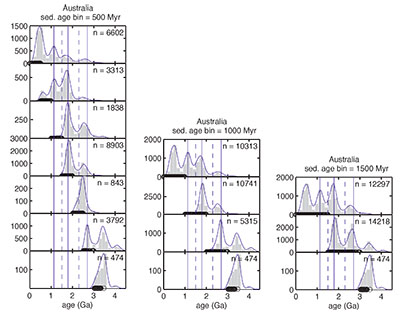
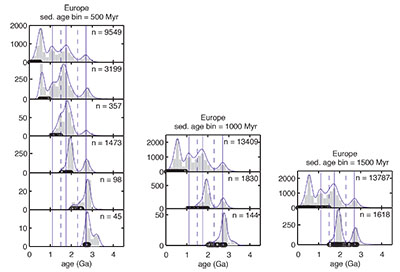
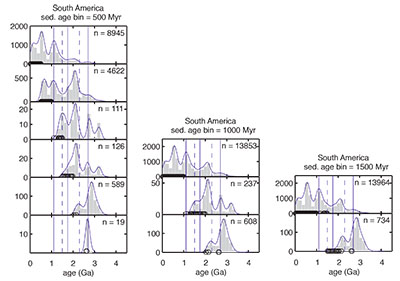
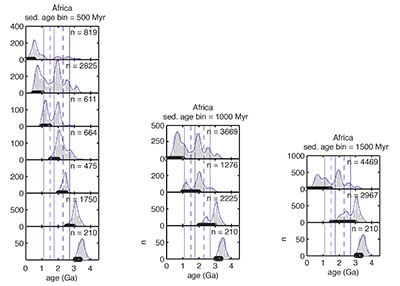
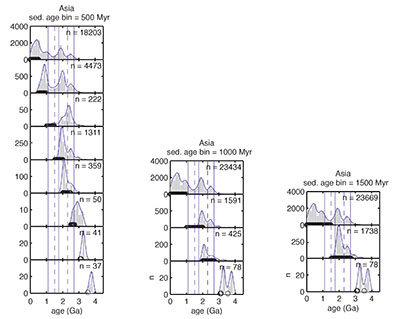
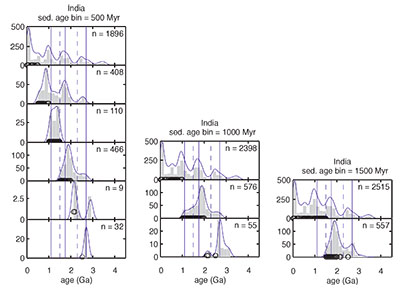
Figure S-2 Zircon U-Pb age distribution for detrital zircons from North & Central America, Australia, Europe, South America, Africa, Asia and India using sediment age intervals of 500, 1000 and 1500 Myr (indicated at the top of each panel). Same symbols and labelling as in Figure S-1.

Figure S-3 Position of zircon age peaks (crosses) as a function of the bin size for the sediments. See Methods for peak finding algorithm. The position of the age peaks at 2.7, 1.8 and 1.2 Ga (vertical bands of data) and troughs at 2.4 and 1.4 Ga (vertical gaps in data) are robust and do not vary with the size of the bin size.

Figure S-4 Position of zircon age peaks (blue circles) as a function of the age of the sediment they are found within. Same as Figure 2a, but with peak positions (blue circles) not scaled to the number of zircon and peak height. Vertical bands of data show the age peaks at 2.7, 1.8 and 1.2 Ga, that do not vary with sediment age. Vertical bands with no data show troughs in zircon age distributions that appear on all continents in sediments of all ages. Open circles are for Australia and are likely due to the high sampling density there (see text).

Figure S-5 Position of zircon age peaks (circles) as a function of the age of the sediment they are found within. Same as Figure 2a, but only using zircons with U-Pb ages with <10 % discordance (Voice et al., 2011)
Voice, P.J., Kowalewski, M., Eriksson, K.A. (2011) Quantifying the timing and rate of crustal evolution: Global compilation of radiometrically dated detrital zircon grains. Journal of Geology 119, 109-126.
. The number of data are reduced to 98,154. The same pattern is seen in the filtered and unfiltered data, indicating that discordance is not biasing the data.Figures and Tables

Figure 1 Frequency of U-Pb crystallisation ages in detrital zircons from North + Central America and Australia as a function of the age of the sediment in which they were found (different panels). Data from Voice et al., 2011
Voice, P.J., Kowalewski, M., Eriksson, K.A. (2011) Quantifying the timing and rate of crustal evolution: Global compilation of radiometrically dated detrital zircon grains. Journal of Geology 119, 109-126.
. Each panel shows a histogram of zircon ages from sediments deposited during a 500 Myr interval, starting from 4000 Ma at the bottom and becoming younger upwards in the figure. Moving from bottom to top, each panel can be viewed as a snapshot in a time-lapse movie of crustal age distribution. For each sediment age interval, both a histogram of the U-Pb ages (blue, scale on y-axis) and a kernel density function (grey curves, kernel width = 100 Myr) are shown. Sediment ages are the reported minimum ages and are shown by black open circles along x-axis. The total number of zircon analyses for each bin is shown in upper right hand corner of each panel. The sediment age range is also shown between the two panels. Reference lines are shown for peaks (solid lines) and troughs (dashed). These peaks and troughs persist in sediments of all ages and on all continents (see Figs. S-1 and S-2) indicating that destruction of pre-existing crust did not produce the age peaks or troughs.
Figure 2 Comparison of zircon U-Pb ages and Hf isotopic compositions with Re depletion ages of mantle xenoliths. (a) Positions of U-Pb zircon age peaks (blue circles) as a function of the age of the sediment in which they were found (sediment age interval = 400 Myr). The size of the circle is scaled to the height of the peak, times the number of zircons in each sediment interval, to give an indication of the robustness of the peak (see Fig. S-4 for an unscaled version). The vertical bands of dots (highlighted by grey bands) correspond to times of super continent formation: Pangea (P), Gondwana (G), Rodinia (R), Nuna (N), Superia (S) and Vaalbara (V). Only a few small age peaks are found around 1.5 and 2.3 Ga, indicating that little continental crust of this age ever existed. See Methods in Supplementary Information for discussion. (b) Epsilon Hf of zircons versus zircon crystallisation age (data from Belousova et al., 2010
Belousova, E.A., Kostitsyn, Y.A., Griffin, W.L., Begg, G.C., O'Reilly, S.Y. Pearson, N.J. (2010) The growth of the continental crust: Constraints from zircon Hf-isotope data. Lithos 119, 457-466.
). Running mean (black line) and standard deviation (grey line) are also shown (window for averaging = 100 Myr). Note the lack of large variations in either the mean or standard deviations until after 1 Ga. (c) Histogram (red bars) of Re depletion age of mantle xenoliths showing that highly depleted lithosphere formation rates were highest around 2.7 Ga and decreased to near zero by ~1 Ga (data from Pearson et al., 2007Pearson, D.G., Parman, S.W. Nowell, G.M. (2007) A link between large mantle melting events and continent growth seen in osmium isotopes. Nature 449, 202-205.
). The evolution of the continents is divided into three time periods: destruction rates > growth rates (4.5-3 Ga), growth rates > destruction rates (3-1 Ga) and growth rates = destruction rates (1 Ga - present), see text and Figure 3 for discussion. The boundaries at 1 and 3 Ga correspond to the major changes in rates of depleted mantle lithosphere formation.
Figure 3 Schematic model of continental growth consistent with the zircon U-Pb and Hf data. The lack of a scale bar on the y-axis indicates that the model shown here is speculative and should not be taken as quantitative. Hypothetical rates of continent growth (blue solid line) and destruction (red dashed line) are shown as exponentially decreasing (assuming the early Earth was hotter and mantle convection/melting was more vigorous), with the growth rate oscillating. Destruction (preservation) rates probably also varied, but are not shown for clarity. The black line indicates cumulative crustal volume starting at 0 and ending at the present day volume. Prior to ~3 Ga, destruction outpaces growth and little continental volume is preserved. Prior to 4 Ga (faded lines), no crust is preserved, other than as detrital zircons. The hypothesis suggested here is that the decrease in destruction rates was faster than crustal growth rates, such that at ~3 Ga, growth outpaces destruction and significant volumes of continental crust can be preserved. This corresponds to the formation of highly depleted mantle (Fig. 2c) and possibly to the onset of plate tectonics. By ~1 Ga, both growth and destruction rates may have fallen to minimal values, producing little net crustal growth. Reworking of existing crust becomes the dominant zircon-producing process, as suggested by the large variations in zircon Hf isotopic composition after 1 Ga. Grey bands are taken from Figure 2.
Back to article
Supplementary Figures and Tables

Figure S-1 Distribution of U-Pb ages in detrital zircons (histograms and overlain kernel density functions) in sediments of different ages. Data from Voice et al., 2011
Voice, P.J., Kowalewski, M., Eriksson, K.A. (2011) Quantifying the timing and rate of crustal evolution: Global compilation of radiometrically dated detrital zircon grains. Journal of Geology 119, 109-126.
. Sediment ages are the reported minimum ages and are shown by black circles along x-axis. Sediments were binned in 700 Myr increments. Total number of zircon analyses for each bin is shown in upper right hand corner of each panel. Sediment age range shown along right side of figure. Grey vertical bands show three main peaks in peaks in zircon age distribution. Dashed lines show two main minima in age spectrum. These peaks and minima persist in sediments of all ages and on all continents (see online figures for plots for all continents and a range of sediment age bins). The invariance of these peaks through time suggests that they are pulses of crustal growth.
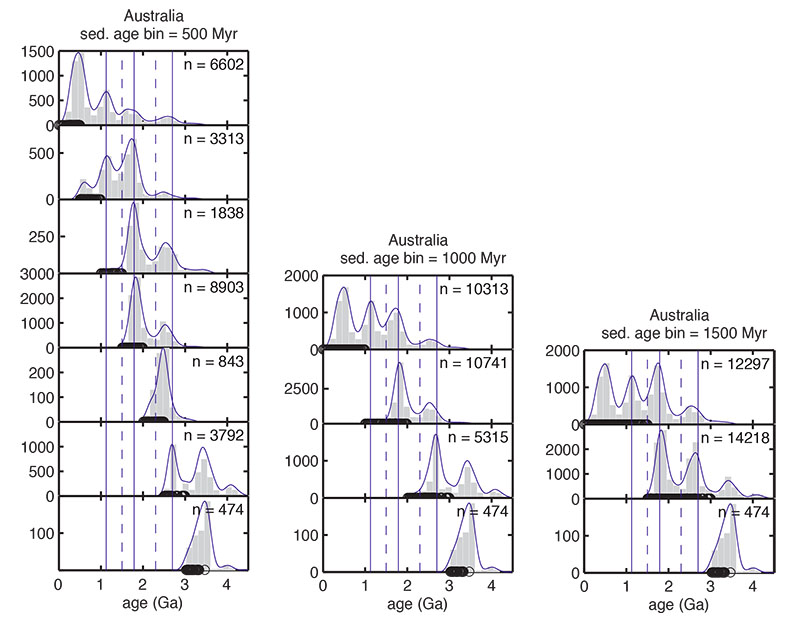
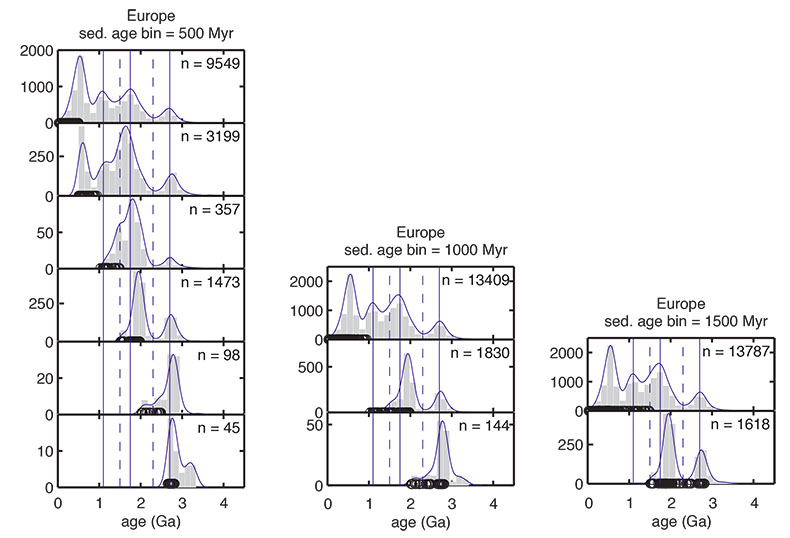
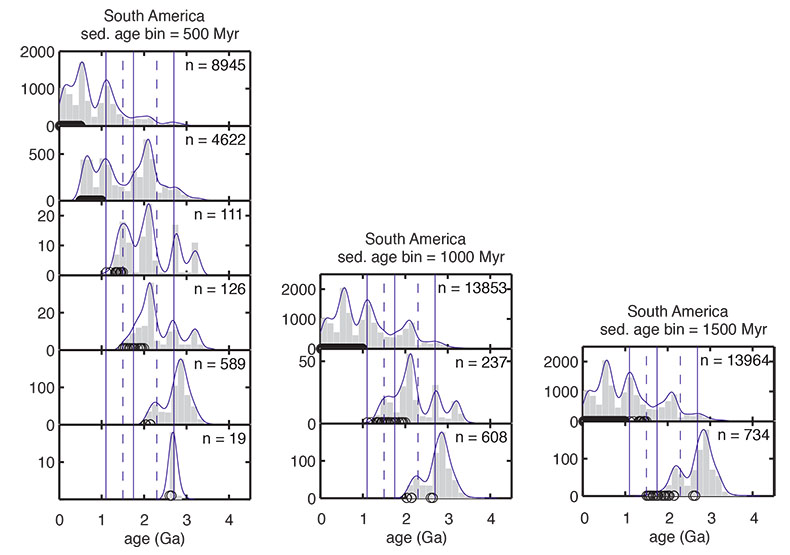
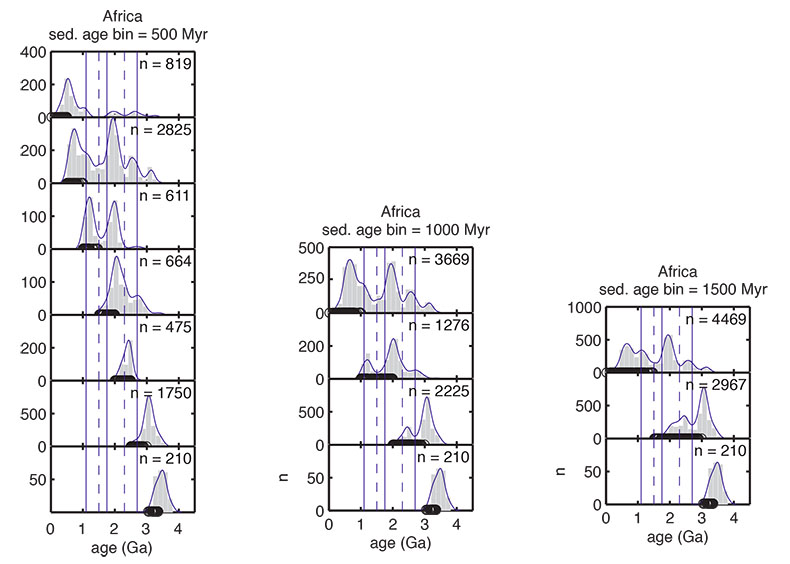
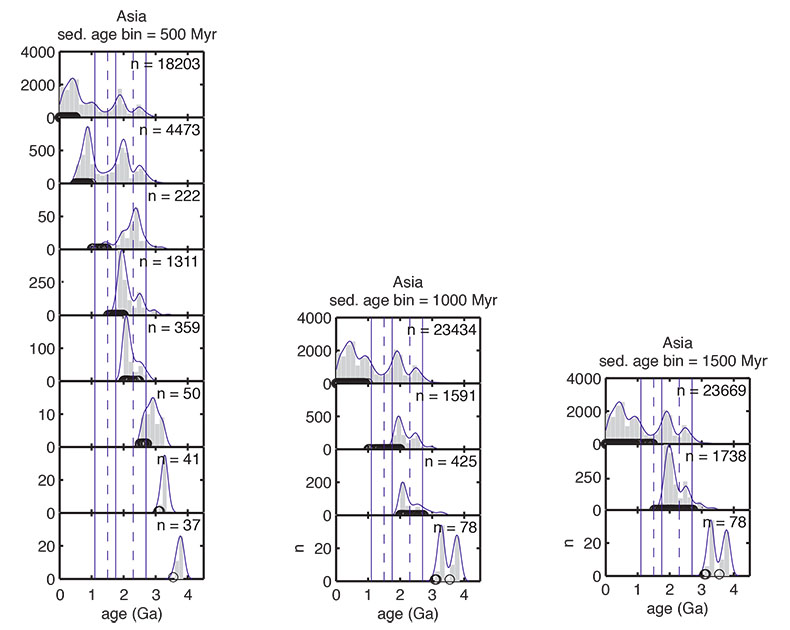
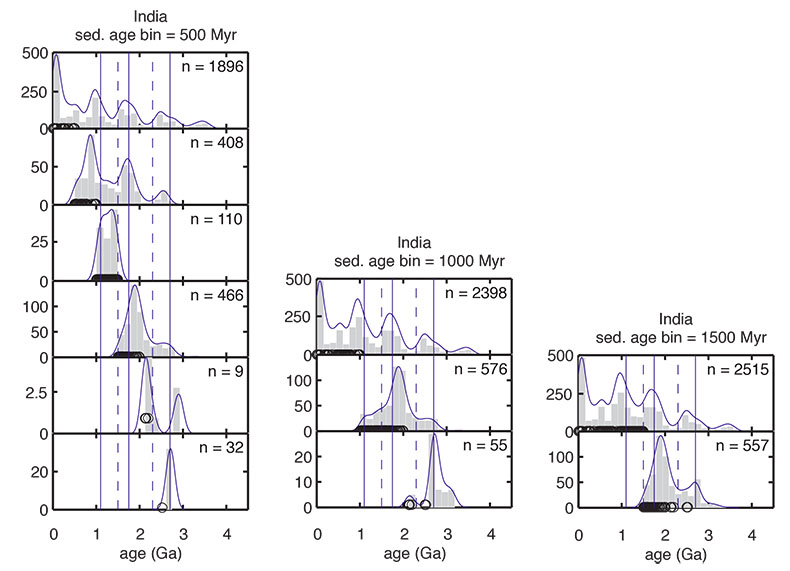
Figure S-2 Zircon U-Pb age distribution for detrital zircons from North & Central America, Australia, Europe, South America, Africa, Asia and India using sediment age intervals of 500, 1000 and 1500 Myr (indicated at the top of each panel). Same symbols and labelling as in Figure S-1.

Figure S-3 Position of zircon age peaks (crosses) as a function of the bin size for the sediments. See Methods for peak finding algorithm. The position of the age peaks at 2.7, 1.8 and 1.2 Ga (vertical bands of data) and troughs at 2.4 and 1.4 Ga (vertical gaps in data) are robust and do not vary with the size of the bin size.

Figure S-4 Position of zircon age peaks (blue circles) as a function of the age of the sediment they are found within. Same as Figure 2a, but with peak positions (blue circles) not scaled to the number of zircon and peak height. Vertical bands of data show the age peaks at 2.7, 1.8 and 1.2 Ga, that do not vary with sediment age. Vertical bands with no data show troughs in zircon age distributions that appear on all continents in sediments of all ages. Open circles are for Australia and are likely due to the high sampling density there (see text).

Figure S-5 Position of zircon age peaks (circles) as a function of the age of the sediment they are found within. Same as Figure 2a, but only using zircons with U-Pb ages with <10 % discordance (Voice et al., 2011). The number of data are reduced to 98,154. The same pattern is seen in the filtered and unfiltered data, indicating that discordance is not biasing the data.






